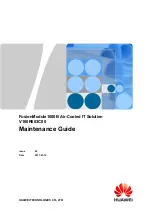
Chapter 3: Using the HOBO U30 Station
HOBO U30 Remote Monitoring System User’s Guide
41
Power
The HOBO U30 Station uses a GSM radio to make connections to mobile
network towers and transmit the data to HOBOlink.com. The HOBO U30
Station has a 4-volt sealed lead-acid battery that powers this transmission.
However, much like a mobile phone, the battery will start to run down if it is
not recharged. Therefore, the system requires either a solar panel or an AC
adapter plugged in to ensure the battery does not run too low.
Important: Always plug the battery in before plugging in the solar panel or
AC adapter. When turning off power, unplug the solar panel or
AC adapter first and then unplug the battery. Damage may occur
if the battery is unplugged before the solar panel or AC adapter is
disconnected.
Keep in mind that even rechargeable batteries eventually fail, and will not be
able to be recharged. With regular usage, the battery should last more than
two years. See the next section for details on how to maximize battery life.
Important: Due to the self-discharge characteristics of this type of battery, it
is imperative that you charge the battery for at least 12 hours
every six months at minimum, even if you are not actively using
the HOBO U30 Station. Otherwise, permanent loss of battery
capacity may occur.
Maximizing battery life
Battery life will vary with the following factors:
•
The connection interval (most important factor)
•
Sensor excitation current and warm-up time
•
Logging interval (and sampling interval, if applicable) selected
•
Number of sensors being used
•
Operating environment (e.g., temperature)
•
Size of the solar panel (if applicable)
•
Quality and quantity of solar light (if a solar panel is installed)
Chapter 3: Using the HOBO U30 Station
42
HOBO U30 Remote Monitoring System User’s Guide
Here are some tips to maximize battery life:
•
Reduce the connection interval.
The single most significant factor
that drives battery life is the connection interval. Reducing the
connection interval will result in an immediate and substantial
reduction in power consumption.
•
Maximize your signal strength.
If possible, place the HOBO U30
Station in a location that gets good cellular signal strength. Weak
signal strength will result in more power consumed per call and
more frequent attempts at calls (retries). See page 36 for details on
checking signal strength with HOBOware Pro.
•
Use the Night Mode feature.
This allows you to set up two
connection intervals for readouts: a more frequent schedule when
needed and a less frequent schedule during a less critical time.
•
Reduce warm-up time.
If you are using excitation voltage, select
the shortest warm-up time needed for the sensor.
•
Ensure that your solar panel gets full sunlight.
Solar panels are
extremely sensitive to partial shading. Obstructing even a single cell
of the panel will result in significant loss of charging power.
•
Use the sampling interval only if you have sensors that support
measurement averaging.
The following Smart Sensors and input
adapters support measurement averaging:
-
12-bit Temperature S-TMB-M0XX
-
12-bit 4-20 mA Input Adapter S-CIA-CM14
-
12-bit Voltage Input Adapter S-VIA-CM14
-
Photosynthetically Active Radiation (PAR) S-LIA-M003
-
Silicon Pyranometer (Solar Radiation) S-LIB-M003
-
Barometer S-BPB-CM50
Battery voltage
The normal operating range for the battery is 3.9 to 4.3 volts. If the voltage
drops below the normal range, the HOBO U30 Station will change behavior
to maximize the remaining voltage until the battery can be recharged.
Alternatively, you may occasionally see a voltage level higher than 4.5 volts.
The following chart explains what occurs at various voltage levels.















































